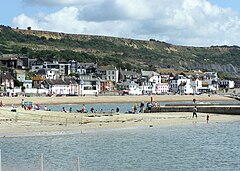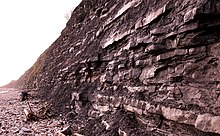

Title:
Remarkable Creatures
Author: Tracy Chevalier
Pages: 320
Published: 2010 Plume (orig. 2009)
Photo Credits: Courtesy of Wikipedia
My Rating: 4 stars
For a book that has been on my wishlist since it was first released, the story came as quite a surprise. I think I saw "Tracy Chevalier" and stuck it on my wishlist. If I'd known that it had so many other things to make me enjoy it, I certainly wouldn't have waited until I saw it on a shelf in Target to pick it up.
First, the time period. This takes place during Regency Era Britain (a well known era for fans of Pride and Prejudice). I like the time period because it seems to balance old and new. It is the era of the gentleman and the servant, before the growth of middle class yet after new advancement in many fine arts. Technically, Regency Era only lasted from 1811 to 1820, while George IV was the Prince Regent, although in terms of trends and styles it covers 1795-1837, from the Georgians to the Victorians. Obviously the era had its problems, don't they all? There were wars (with Napoleon and elsewhere) and lavish spending in the aristocracy brutally contrasted the squalor of the poor.
 |
| Assembly Rooms provided entertainment for many. |
Next, the location. Lyme Regis (nicknamed The Pearl of Dorset) is a place that has struck my fancy since first reading Persuasion. It is well known for The Cobb (a harbor wall first found mentioned in 1328), and plays a vital role in that book, and is also a setting for The French Lieutenant's Woman by John Fowles.
 |
| A view of the Cobb with boats grounded at low tide. |
 |
| A view of Lyme Regis from the Cobb. |
Third, the characters. Although I didn't know anything about
Mary Anning or
Elizabeth Philpot before reading this book, I wish that I'd known that Remarkable Creatures is more than historical fiction, it is closer to a biographical novel (or as some say, historical FACTion) and reminded me of
Irving Stone (a good thing!) It seemed to be a fair representation, and was definitely a good story. As unmarried women (a.k.a. spinsters) they provided an interesting point of view on this time period, especially due to Mary's involvement in the scientific community (which, due to her gender, wasn't what it should have been.)
 |
| Mary Anning with her dog Tray. |
Finally, the topics. Lyme Regis and Mary Anning are known for the discovery of fossils. As a child, Mary would collect "curies" on the coast to sell to tourists, helping to support the family from a young age.
 |
The "Jurassic Coast" at Charmouth,
where Anning made some discoveries. |
The ocean and the coastline play quite a role in this book, not only because this is where fossils were searched for, but because it really shaped the tone and meter of life in the area. From Elizabeth Philpot's laments that her hands were stained from digging through the Blue Lias clay, to the danger of landslips, (contrasted by the opportunity a landslip provided for discovering previously hidden fossils,) the town and the coast make the setting a big part of the book.
 |
Blue Lias cliffs at Lyme Regis...easy to
imagine this clay staining your hands! |
 |
| Landslip, east of Lyme Regis. |
Small fossils, like
ammonites, didn't cause much of a stir, since they'd been around a while, and were thought of as coiled up snakes. The discovery of some of the larger fossils, however, spurred some disturbing thoughts for many in terms of what science says about God and the bible. At the time, considering an interpretation of the bible apart from traditional beliefs was a dangerous thing, and could see you ostracized from society.
 |
| Saint Michael's Church, the parrish church. |
The established opinion was that God created the world in 6 literal 24-hour days, and since God is perfect, he created the world perfectly--he made no mistakes. This necessarily means that everything which is in the world is God's perfect creation, the corollary being that since creation was perfect, everything that was in the world at the time of creation remains the same today. The idea of extinction was a novel, renegade idea. To believe that creatures could become extinct was to entertain the idea that God made a mistake. It was fascinating to peek into such a pivotal time as far as world-view. Something that I take for granted: being able to consider, interpret, and believe as I choose, was almost unheard of then.
 |
| Anning's Plesiosaurus |
 |
| Ichthyosaurus skull |
I hope you've enjoyed my little tour through the history that I wish I'd known before reading the book. I think
Tracy Chevalier does a fabulous job at bringing history to life, in a very readable, accessible manner. If you enjoy grounded historical fiction (meaning, not romantic or idealistic but something that feels fully historical as well as being a good story,) Chevalier is a great find. Her books include the following
(info taken from her website):
- The Virgin Blue
 (1997) American woman searches for French ancestors and uncovers more than she’d bargained for.
(1997) American woman searches for French ancestors and uncovers more than she’d bargained for.
- Girl With a Pearl Earring
 (1999) Modest Dutch maid becomes poster girl for the painter Johannes Vermeer.
(1999) Modest Dutch maid becomes poster girl for the painter Johannes Vermeer.
- Falling Angels
 (2001) Two families love and feud among the gravestones of London’s Highgate Cemetery.
(2001) Two families love and feud among the gravestones of London’s Highgate Cemetery.
- The Lady and the Unicorn
 (2003) Love is blind among the weavers of a lavish set of medieval tapestries.
(2003) Love is blind among the weavers of a lavish set of medieval tapestries.
- Burning Bright
 (2007) Two pre-teens bond with radical painter-poet William Blake in 18th-century London.
(2007) Two pre-teens bond with radical painter-poet William Blake in 18th-century London.
- Remarkable Creatures
 (2009) Two eccentric women search for fossils on English beaches.
(2009) Two eccentric women search for fossils on English beaches.











(1997) American woman searches for French ancestors and uncovers more than she’d bargained for.
(1999) Modest Dutch maid becomes poster girl for the painter Johannes Vermeer.
(2001) Two families love and feud among the gravestones of London’s Highgate Cemetery.
(2003) Love is blind among the weavers of a lavish set of medieval tapestries.
(2007) Two pre-teens bond with radical painter-poet William Blake in 18th-century London.
(2009) Two eccentric women search for fossils on English beaches.
I loved this book too, especially as my family always used to go on holiday to Lyme Regis when I was little. I even found some fossils once :)
ReplyDeleteI liked it for all the same reasons you did, especially the religion-science aspects. I haven't read anything else by Tracy Chevalier yet, but I really want to.
I have this book waiting on my stacks, and it sounds FASCINATING!!!! I can't wait to get to it.
ReplyDeleteTracy Chevalier is one of my favourite authors and I have loved all of her books with the exception of Burning Bright which didn't quite hit the spot.
ReplyDeleteMust Get My Hands On This One!!
ReplyDeleteSam, holiday in Lyme Regis? *sigh* I'll get there someday. I haven't read The Lady and the Unicorn or Burning Bright, but I've enjoyed her others.
ReplyDeleteAndi, I know! I had no idea what I was missing out on, and I love that women had such a great part in this revolutionary era.
Good to know, Lovely Treez, since that's one of the two I haven't read. I hadn't even heard of it until looking looking at Chevalier's website. I own The Lady and Unicorn, but am about as equally in the dark about it as I was Remarkable Treasures.
I know, Belle, I feel like if I'd only known!